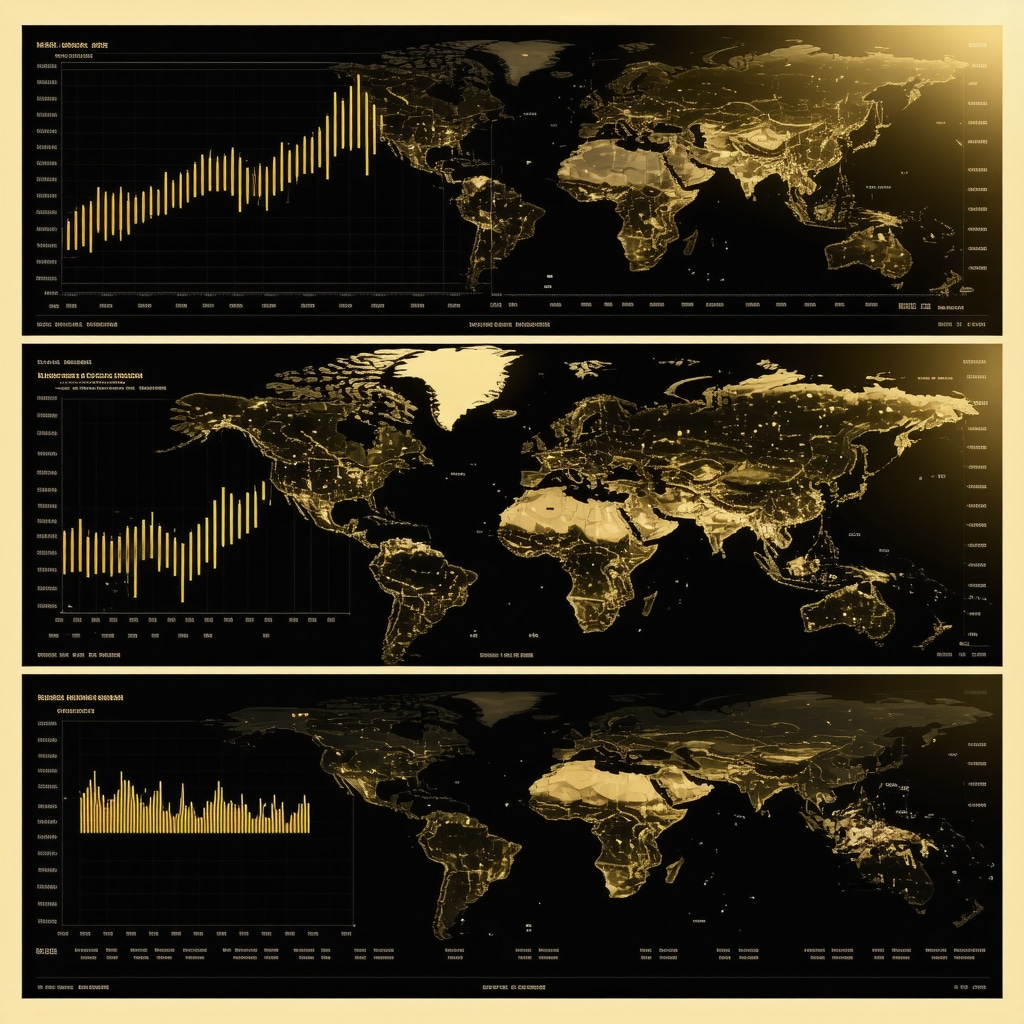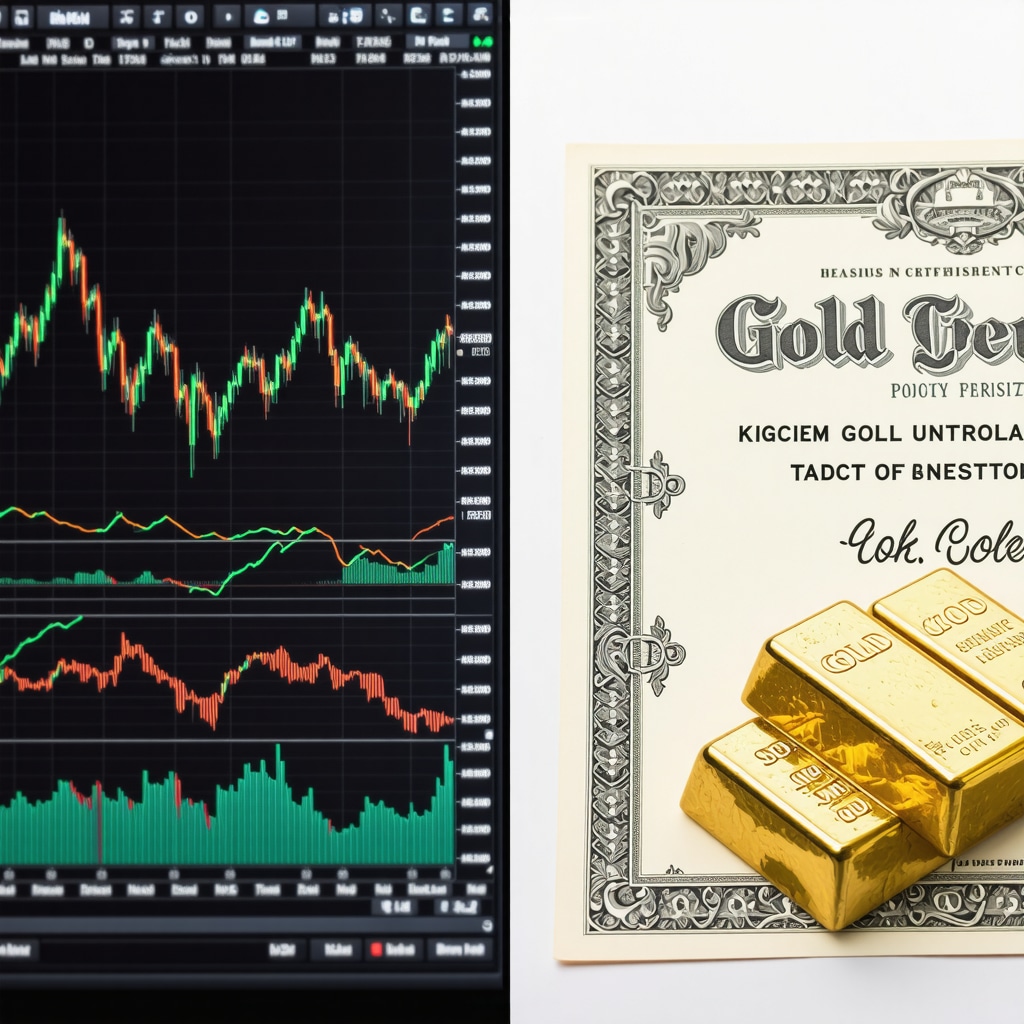When Gold Beckons: Futures or Stocks?
Gold has always glittered in the eyes of investors, but the real question is where to stake your claim for the best returns — in the swift currents of gold futures or the more grounded world of gold stocks? Imagine standing at a crossroads with two dazzling paths, each promising riches but demanding a unique kind of savvy. It’s a tale as old as investing itself: fast-paced speculation versus patient, strategic growth.
Gold Futures: The Thrill Ride of the Precious Metals World
Gold futures contracts offer a tantalizing promise: leverage. With a relatively small upfront margin, you control a large amount of gold, amplifying gains if the price moves in your favor. But beware, this leverage cuts both ways. The volatility of gold futures can feel like riding a roller coaster blindfolded, thrilling but risky. For the adept trader with a keen eye on market trends and a stomach for sudden swings, futures can produce spectacular returns.
Is chasing gold futures like gambling at the casino or investing with an edge?
In truth, success in gold futures trading hinges on expertise, timing, and a robust risk management strategy. For those curious about mastering this domain, expert gold futures trading tips offer a treasure trove of insights to navigate the minefield.
Gold Stocks: Mining the Wealth Beneath the Surface
On the other side, gold stocks represent ownership in companies mining the precious metal. Unlike futures, these stocks can offer dividends and the potential for compounded growth as companies expand operations or discover new reserves. While not immune to market fluctuations, gold stocks often align more closely with the broader equity market, providing a different risk-return profile.
Investors seeking long-term growth might find solace in gold stocks, as evidenced by various analyses on long-term benefits of gold stocks. Moreover, their performance can sometimes outpace physical gold in bullish markets.
What Does the Crystal Ball Say About Returns?
Historical data paints a nuanced picture. Futures can deliver higher short-term returns thanks to leverage but can also trigger devastating losses. Gold stocks, while generally less volatile, depend heavily on company performance, management, and geopolitical factors.
According to a comprehensive report by the World Gold Council, “gold stocks have historically provided higher total returns than physical gold over the long term but come with increased company-specific risks.” (Source: World Gold Council)
So, Where Should You Place Your Bet?
Choosing between gold futures and gold stocks isn’t a simple yes-or-no decision but a matter of aligning with your investment style, risk appetite, and time horizon. For those who enjoy the adrenaline of short-term trading and can dedicate time to market analysis, futures might be the glittering prize. Conversely, patient investors with a knack for evaluating company fundamentals could find gold stocks a steadier path to wealth.
If this debate has you pondering your next move, why not dive deeper into strategies to balance your gold investments across various vehicles? Your portfolio might just thank you for it.
What’s your take? Have you found success in the fast lane of futures or the steady climb of stocks? Share your experiences and let’s keep the golden conversation going!
Managing Volatility: Strategies to Navigate the Gold Investment Spectrum
Volatility in gold futures trading is often perceived as a double-edged sword. However, savvy investors leverage sophisticated risk management tools such as stop-loss orders, position sizing, and technical analysis to harness this volatility effectively. Diversification within the gold sector—combining futures with stocks or physical holdings—can also mitigate risk exposure while optimizing potential returns.
On the flip side, gold stocks demand a diligent assessment of company fundamentals, including mining reserves, operational costs, geopolitical risks, and management quality. Investors often complement fundamental analysis with macroeconomic indicators to anticipate how broader market shifts might impact mining equities.
How Can Advanced Analytics Transform Your Gold Futures and Stocks Investment Approach?
In the era of big data and AI-powered analytics, integrating quantitative models enables investors to identify patterns and predict price movements with greater precision. Tools that analyze sentiment, market liquidity, and global economic indicators offer a competitive edge in timing entry and exit points for both futures and stocks. Embracing these technologies can transform speculative trading into a more calculated and informed investment strategy.
For those interested in enhancing their analytical toolkit, understanding the best gold trading techniques for volatile markets can provide actionable insights to navigate complexity.
Institutional Influence: How Central Banks Shape Gold Markets
Central bank gold buying has emerged as a significant force influencing gold price trends and market dynamics. These institutions often accumulate gold to diversify reserves and hedge against currency risks, impacting global supply-demand balance. Their strategic purchases can signal confidence in gold’s value, potentially triggering bullish market sentiment among private investors.
According to the World Gold Council, central banks collectively purchased over 650 tonnes of gold in recent years, marking one of the largest accumulation phases in decades. This institutional demand underpins the resilience of gold as a long-term store of value, especially during periods of geopolitical or economic uncertainty.
Understanding these macro-level dynamics is crucial for investors aiming to anticipate price movements beyond traditional market indicators.
If you’re keen to explore the impact of institutional buying in more detail, check out our deep dive on central bank gold purchases and their influence on market dynamics.
Integrating Gold Futures and Stocks: Crafting a Synergistic Portfolio
Blending gold futures and stocks within a diversified portfolio can capitalize on the unique advantages of each asset class. Futures offer tactical opportunities for short-term gains and hedging, while stocks provide potential for compounded growth and income streams via dividends. By balancing exposure across these instruments, investors can tailor risk profiles and enhance portfolio resilience.
Strategic allocation requires ongoing evaluation of market conditions and individual investment goals. For example, during periods of heightened volatility, increasing futures exposure might amplify returns but also risk, whereas favoring stocks could provide steadier growth. Dynamic portfolio rebalancing informed by comprehensive market analysis is key.
To gain practical guidance on constructing such balanced portfolios, explore our resource on best strategies to balance your gold investments.
Investors, what combinations of gold futures and stocks have worked best in your experience? Join the conversation by sharing your insights and strategies below!
Leveraging Big Data and AI: The New Frontier in Gold Investment Mastery
In today’s hyper-connected market environment, the integration of big data analytics and artificial intelligence (AI) is revolutionizing gold investment strategies. Both gold futures traders and gold stock investors are increasingly turning to these sophisticated tools to decode complex market signals and enhance decision-making precision. Unlike traditional methods relying heavily on gut feeling or basic technical indicators, AI-driven models assimilate vast datasets — from macroeconomic indicators and geopolitical events to social media sentiment — to forecast price trajectories with unprecedented granularity.
For instance, machine learning algorithms can detect subtle price pattern anomalies in gold futures markets, enabling traders to identify optimal entry and exit points that were previously hidden in statistical noise. Similarly, AI can assess corporate earnings reports, operational metrics, and geopolitical risks impacting gold mining companies, thereby refining the valuation models used to pick outperforming gold stocks.
How Do AI-Enhanced Quantitative Models Outperform Traditional Gold Trading Tactics?
Quantitative models powered by AI harness multi-dimensional data inputs and adaptive learning mechanisms, allowing investors to dynamically recalibrate strategies in response to evolving market conditions. Unlike static models, these systems improve over time, fine-tuning their predictive accuracy by learning from past successes and failures.
According to a detailed analysis published in the CFA Institute Journal, AI-informed commodity trading strategies, including gold, have demonstrated statistically significant improvements in risk-adjusted returns versus conventional approaches, particularly when combined with fundamental analysis.
Institutional Gold Demand: Reading the Subtle Signals Behind Central Bank Purchases
While retail investors often react to price movements and news headlines, institutional actors like central banks operate with strategic intent that can presage long-term trends. Central bank gold purchases are not merely reactive but are carefully calibrated moves influenced by currency diversification policies, inflation hedging, and geopolitical considerations. Recognizing the timing and scale of these acquisitions can offer investors a critical advantage.
For example, the recent surge in central bank gold buying amid global economic uncertainty signals a deliberate shift toward gold as a reserve asset, underpinning its role as a hedge against fiat currency depreciation and systemic risk. This institutional demand can create upward pressure on prices, often preceding wider market rallies in gold equities and futures.
What Are the Macro-Economic Indicators That Signal Institutional Gold Accumulation?
Monitoring central bank balance sheets, international reserve allocations, and official statements provides invaluable clues. Additionally, geopolitical risk indices and inflation expectations, tracked by entities such as the International Monetary Fund (IMF), often correlate with increased institutional gold demand. Investors attuned to these indicators can anticipate market inflection points more effectively.
Crafting a Synergistic Portfolio: Harmonizing Gold Futures and Stocks for Optimal Risk-Reward
Strategic portfolio construction in gold investment transcends simplistic allocation between futures and stocks. The goal is to synthesize their distinct characteristics into a cohesive investment thesis that amplifies returns while mitigating inherent risks. For example, employing gold futures can provide tactical agility to capitalize on short-term price volatility, while gold stocks offer exposure to operational growth and dividend income streams.
Dynamic rebalancing is essential, as market conditions and risk appetites evolve. During geopolitical tensions or inflationary spikes, increasing futures exposure can hedge against rapid price moves. Conversely, in stable growth phases, emphasizing gold stocks may yield superior compounding benefits.
Investors should also consider incorporating physical gold and exchange-traded funds (ETFs) to diversify sources of gold exposure further, thereby smoothing portfolio volatility.
For those seeking a detailed blueprint on integrating these elements, our comprehensive guide on balancing gold investments offers actionable strategies tailored to various risk profiles and market cycles.
What innovative combinations of gold investment vehicles have you found successful in navigating the complexities of today’s markets? Engage with our expert community to share your insights and refine your approach.
Harnessing AI and Big Data to Decode Gold Market Complexities
As gold markets grow increasingly sophisticated, investors who leverage AI-driven analytics are gaining unprecedented clarity into price dynamics—particularly when balancing gold futures and stocks. By assimilating vast troves of data ranging from macroeconomic indicators to real-time sentiment analytics, artificial intelligence transcends traditional charting methods, offering nuanced predictive insights that sharpen timing and asset selection.
These AI models dynamically adapt to shifting market regimes, exploiting subtle correlations and nonlinear price patterns often missed by human analysis. For example, advanced gold trading techniques now incorporate machine learning to identify optimal entry points in futures markets while simultaneously flagging undervalued gold mining stocks poised for breakout growth.
How Can AI-Powered Quantitative Strategies Mitigate Risks Inherent in Gold Futures and Stocks?
AI-enhanced quantitative models excel at risk mitigation by continuously recalibrating exposure based on volatility forecasts and sentiment shifts—reducing drawdowns during turbulent periods. A 2023 study in the CFA Institute Journal demonstrated that commodity traders using AI-based strategies outperformed conventional approaches with superior risk-adjusted returns, particularly in gold futures and equities markets.
Integrating these insights allows investors to build portfolios that dynamically balance the short-term leverage of futures with the fundamental growth potential of stocks, optimizing for both alpha generation and downside protection.
Decoding Institutional Signals: Central Banks’ Quiet Gold Accumulation and Its Market Implications
Institutional gold demand, especially from central banks, is a pivotal yet often underappreciated driver of gold price trajectories. Central banks strategically accumulate gold to diversify reserves and hedge against currency devaluation, impacting supply-demand fundamentals over the medium to long term.
Recent surges in official gold purchases signal growing geopolitical and inflationary concerns, subtly foreshadowing potential bullish cycles in gold futures and mining equities. Staying attuned to these macro signals is critical for investors seeking preemptive positioning rather than reactive chasing.
For a deeper exploration, see our analysis on central bank gold buying and global demand trends, which delves into how these institutional moves can serve as leading indicators for savvy market participants.
What Macro Indicators Best Forecast Central Bank Gold Buying Patterns?
Key markers include shifts in international reserve compositions, inflation expectations, and geopolitical risk indices curated by global bodies like the IMF. Monitoring these alongside central bank balance sheet disclosures offers investors a sophisticated toolkit to anticipate institutional accumulation phases, enabling strategic allocation adjustments in both futures and stock positions.
Elevating Your Portfolio: Synergistic Integration of Gold Futures, Stocks, and Alternative Gold Vehicles
The most resilient gold investment strategies blend asset classes to harness their distinct benefits. Futures provide tactical agility and leverage for short-term positioning, while stocks offer growth and dividends tied to operational performance. Complementing these with physical gold or ETFs further diversifies risk and smooths volatility.
Dynamic rebalancing that responds to evolving macroeconomic conditions and institutional demand patterns is essential. Periods of heightened uncertainty may warrant increased futures exposure for rapid response, whereas stable growth phases favor a tilt toward fundamentally strong gold mining equities.
Explore our comprehensive guide on balancing gold investments effectively to craft a customized, risk-aware portfolio aligned with your investment horizon.
How are you leveraging AI insights or institutional demand signals in your gold investment approach? Share your strategies and join the conversation to refine your edge in this ever-evolving market!

Expert Insights & Advanced Considerations
Leverage AI-Driven Analytics to Balance Risk and Return in Gold Investments
Integrating AI-powered quantitative models into your gold portfolio strategy is no longer optional but essential for sophisticated investors. These models analyze multidimensional data—including macroeconomic indicators, geopolitical events, and sentiment analysis—to optimize entry and exit points in both gold futures and stocks, reducing exposure to sudden market swings while enhancing alpha potential.
Institutional Movements as Leading Indicators for Strategic Positioning
Central banks’ gold accumulation patterns offer invaluable foresight into long-term market trends. Recognizing shifts in international reserve policies and geopolitical risk indices allows investors to anticipate price inflection points and align their gold futures and stocks exposure accordingly, thus capitalizing on institutional momentum rather than reacting to lagging price signals.
Dynamic Portfolio Rebalancing: The Key to Navigating Volatility
Effective gold investment requires a fluid strategy that adjusts exposure between futures, stocks, and physical gold based on evolving market volatility and macroeconomic conditions. Leveraging futures for tactical agility during heightened uncertainty while emphasizing fundamentally strong gold stocks during stable periods creates a resilient and growth-oriented portfolio.
Synergistic Integration of Diverse Gold Vehicles Enhances Stability and Growth
Combining gold futures, mining equities, ETFs, and physical bullion within a diversified framework harnesses each instrument’s unique advantages. This multidimensional approach mitigates risks inherent in any single asset class and enables tailored risk profiles aligned with specific investment horizons and objectives.
Curated Expert Resources
- World Gold Council Reports – Comprehensive analyses on gold demand trends, central bank activities, and market dynamics provide authoritative context essential for informed investment decisions. Explore their insights at World Gold Council.
- CFA Institute Journal – Delve into rigorous research on quantitative advancements and AI applications in commodity trading, including gold futures and equities, for evidence-based strategy development.
- BuyingGoldNow.com Strategies Collection – A curated suite of articles such as best strategies to balance your gold investments and advanced gold trading techniques offers actionable guidance tailored to diverse investor profiles.
- International Monetary Fund (IMF) Data and Geopolitical Risk Indices – Monitoring these sources equips investors with real-time macro indicators to anticipate institutional gold accumulation phases and global market shifts.
- Specialized AI Trading Platforms – Platforms leveraging machine learning and big data analytics for gold futures and stocks trading provide practical tools to implement sophisticated quantitative strategies in live markets.
Final Expert Perspective
In the intricate arena of gold investment, mastery lies in synthesizing advanced analytics, institutional intelligence, and dynamic asset allocation to navigate the dual worlds of gold futures and stocks. This nuanced approach not only tempers the inherent volatility of futures with the growth potential and dividends of mining equities but also capitalizes on emerging technologies and macroeconomic insights driving market cycles. For investors committed to elevating their gold investment acumen, embracing these expert strategies is paramount. Engage deeply with these concepts, share your professional insights, and explore the rich resources available to refine your portfolio’s resilience and growth potential.
Ready to advance your expertise? Dive into our effective gold investment strategies during market uncertainty and join a community dedicated to mastering the evolving gold market landscape.










